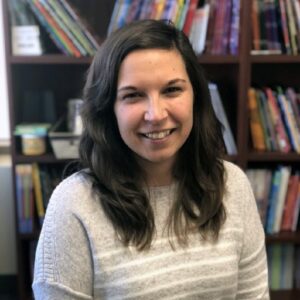 This month’s Industry Insider interview is with Deidra Purvis, an Acquisitions Editor for Free Spirit Publishing, an imprint of Teacher Created Materials. Free Spirit is the “leading publisher of social and emotional learning books for kids, teens, and educators.” The press also notes that it’s “unabashedly pro-kid.” Love that, right?
This month’s Industry Insider interview is with Deidra Purvis, an Acquisitions Editor for Free Spirit Publishing, an imprint of Teacher Created Materials. Free Spirit is the “leading publisher of social and emotional learning books for kids, teens, and educators.” The press also notes that it’s “unabashedly pro-kid.” Love that, right?
Prior to her job as an editor, she spent a lot of time as a classroom teacher and Director of Classroom Services for a book distributor. Don’t worry—we’ll ask about all of that in a moment!
In her free time, Deidra writes creative nonfiction, backpacks, gardens, and rides a bicycle.
Let’s jump to the interview to learn more about Deidra!
RVC: What kind of childhood did you have, and how did it pave the way for your kidlit career?
DP: My childhood was pretty amazing in that I was surrounded by people who loved me.
RVC: I love interviews that start like this!
DP: I grew up in a low-income household in rural Ohio, and I lived close to the land—I always loved nature and animals, and one of my favorite things was mushroom hunting in the woods with my dad every spring. Most of the men who immediately surrounded me also battled with alcohol use disorder, and that impacted me a lot. I grew up very insecure about my weight and other aspects of my body, and that became one of my biggest challenges. I also worried a lot about money.
I was very quiet, but I always had a lot of thoughts that I wanted to share and needed to process. I started journaling when I was around 10 years old to have an outlet for expressing everything that was bottled up in my head, and it grew my love for writing. This all developed an interest in mental health, too. I started reading books about mindfulness and practicing meditation when I was in middle and high school. The books I started reading around that age were intended for adults; and it’s funny looking back and thinking about how much I could have used books by Free Spirit when I was a kid and teenager. My interest in books, writing, and SEL all grew from my childhood.
RVC: So many writers end up writing books they wanted/needed as kids. It makes total sense. Now, what were some of the formative books you read during those early years?
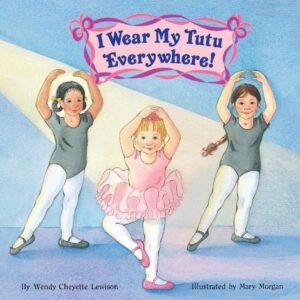 DP: I had a small bookshelf in my room, and I’d read these picture books on repeat: Happy Birthday Moon by Frank Asch, I Wear My Tutu Everywhere by Wendy Cheyette Lewison, Corduroy by Don Freeman, and The Monster at the End of This Book by Jon Stone.
DP: I had a small bookshelf in my room, and I’d read these picture books on repeat: Happy Birthday Moon by Frank Asch, I Wear My Tutu Everywhere by Wendy Cheyette Lewison, Corduroy by Don Freeman, and The Monster at the End of This Book by Jon Stone.
RVC: What a great list!
DP: My mom had a great reading voice, and that’s what drew me to a lot of these books. I remember loving the way she made the echoing noise when the moon would speak, and I remember how dramatic she was when reading Grover’s voice in The Monster at the End of this Book. But I think it’s mostly by chance that these are the books I ended up with. They were all hand-me-downs other than the tutu book, and it’s funny because I was never a girly girl or into tutus.
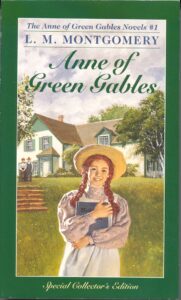 As an older kid, my favorite book was Anne of Green Gables by Lucy Maud Montgomery. Then I started reading more and more nonfiction. Somewhere around late elementary, I wanted to work with animals, so I would go to the library and check out stacks of nonfiction books about animals. Then I got into books about meditation and memoirs.
As an older kid, my favorite book was Anne of Green Gables by Lucy Maud Montgomery. Then I started reading more and more nonfiction. Somewhere around late elementary, I wanted to work with animals, so I would go to the library and check out stacks of nonfiction books about animals. Then I got into books about meditation and memoirs.
RVC: Clearly, the plan for college was to learn to be a K‑12 teacher. What about that career choice appealed to you?
DP: I wanted to be a teacher for two reasons. It was important to me to follow a career path that made a positive impact in the world. I didn’t want take part in a career that I felt was harming people or the planet—I wanted to do good.
RVC: If only more people had such a goal!
DP: Teaching felt like the most impactful career that I could have. I also loved writing, but I didn’t think writing or working in publishing was realistic. I decided the best path for me was to be an English teacher.
RVC: How did the teaching go?
DP: Teaching was hard, so hard. It ended with me wearing my body down and getting very sick. I still believe that teaching is one of the most important careers possible. I loved my students and had so many rewarding moments with them. If I could make one change in the world, I wish teachers had more support in doing the important work that they do.
RVC: Having been a teacher for 25 years, I quite agree. So, you moved into a non-classroom role fairly soon after college. What kinds of things did you do as Director of Classroom Services?
DP: This was such a great move for me! I started calling myself a professional book nerd.
RVC: Love that term!
DP: I was part of a team of former teachers who had the job of curating custom book lists for PK-12 classrooms across the U.S., and I eventually was promoted to be the director of this department. Each season, reps from all the major publishers would present their newly released children’s books to us, and they’d leave samples for us to review. This is what really grew my love for picture books.
Teachers, principals, librarians, and school district contacts would then reach out to my team with specific book needs. For example, a school principal might reach out to us and tell us they wanted to buy classroom libraries for every classroom in the building for grades K‑5. I would ask them questions to get to know the needs and interests of the students I would be serving, and I would use that information to curate custom classroom libraries for each teacher, specifically for their students. Making sure the students in the classroom could see themselves reflected in the books they had access to was important to me, and it showed me how far the book industry still needs to go to allow this to be possible. This job really gave me a look into the market, where the needs were, and where there were gaps. Most importantly, though, it really made me fall in love with kidlit.
RVC: A few years after your undergrad degree, you went back to school for an MFA in creative writing from Hamline. What was the goal?
DP: My goal at Hamline was to spend time doing what I loved doing. I had a vague goal of eventually getting a job in publishing so I could pursue what I loved, but my primary goals were to enjoy my time doing what I loved, to learn as much as possible about the craft, and to be around other writers.
RVC: What was the most useful thing your Hamline experience taught you?
DP: Wow. Everything. I’m happy that I studied fiction, creative nonfiction, and poetry. It really gave me knowledge into all forms of writing that I apply to my job today. I also spent a lot of time with Water~Stone Review, an annual literary journal published by Hamline University. In one class, I served on the editorial board for the journal. We read the final submissions that were being considered for publication and held conversations about which pieces should be published in the journal. This is where I learned how to read as an acquiring editor—How do you decide if something is ready to be published? What qualities do you look for? During my time at Hamline, in addition to serving on this editorial board, I also contributed as a screener for a couple years, and I was Assistant Editor of Creative Nonfiction during my last year at Hamline. Working on Water~Stone Review ultimately taught me the skills I needed to become an acquiring editor. I wouldn’t be here without it.
RVC: I’m a big fan of college literary magazines for exactly this reason–it’s such good training. How did you end up at Free Spirit?
DP: The stars aligned, and I still pinch myself when I reflect on how much I love my job and how I ended up here. My seven years curating and selling custom book lists kept me more engaged in education than I’d ever been before. I had the opportunity to attend annual conferences from organizations like ASCD, ILA, and NCTE. I was talking with leaders in education across the U.S. on a daily basis, so I became really in tune with new research in pedagogy; and, like I said, I came to know the kidlit book market really well.
I also had a personal interest in social and emotional learning (SEL) that started developing way back in my childhood, so when I learned more about school districts implementing SEL, I knew I wanted that to be my focus. I was often tasked with recommending book lists aligned with SEL units; I would research and incorporate SEL in the blogs I would write; and I would also present professional learning webinars through an SEL lens whenever I had the chance. I was so excited about the work being done in schools around SEL that I was considering possibly going back into the classroom if I couldn’t get into publishing.
But then it all came together. I had experience as a teacher, I knew the kidlit market, I was finishing up my MFA in Creative Writing, and I had a special interest in SEL. I was already a fan of Teacher Created Materials (TCM) because I regularly recommended their books to teachers, so when I saw their job posting for acquiring editor for Free Spirit, TCM’s imprint founded forty years ago to provide kids with social emotional resources, it was like the job description was written for me, and I had to go after it.
RVC: What’s the first picture book you acquired while there?
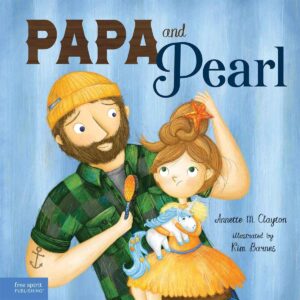 DP: The first picture books that I acquired will be available this summer. Two that I’m most excited for are Papa and Pearl by Annette M. Clayton and illustrated by Kimberley Barnes and Sonia and the Super-Duper Disaster by Rachel Funez and illustrated by Kelly Kennedy.
DP: The first picture books that I acquired will be available this summer. Two that I’m most excited for are Papa and Pearl by Annette M. Clayton and illustrated by Kimberley Barnes and Sonia and the Super-Duper Disaster by Rachel Funez and illustrated by Kelly Kennedy.
RVC: What about each of these books appealed to you as acquiring editor?
DP: Papa and Pearl is a sweet story about a father and daughter immediately following the divorce of Pearl’s parents. It’s full of imagery related to princesses, pirates, and mermaids. What appealed to me about this story was that Annette M. Clayton’s writing is lyrical and imaginative. It’s a fun book any child will love, and it’s also a helpful resource for children experiencing the separation of their parents.
RVC: And what about the other one?
DP: Sonia and the Super-Duper Disaster by Rachel Funez is about a girl who realizes she forgot her mom’s birthday, so she decides to whip up a last-minute super-duper surprise in the kitchen. Sonia has ADHD and anxiety, and throughout the story, she uses strategies to manage challenges as they arise. This one is filled with superhero imagery, and it’s another story that any child can love. It’s hilarious, and it’s also a great resource to demonstrate specific strategies children can use to manage anxiety that may pop up in their own lives.
RVC: I get the sense that Free Spirit’s picture books are different than those by, say, Candlewick, Peachtree, or other kidlit presses.
DP: All of the resources you’ll find in Free Spirit’s catalog are intended to help children and teens think for themselves, overcome challenges, and make a difference in the world. You can use our books to tackle tough topics such as neurodiversity, anger and stress management, childhood and teenage depression, anxiety, grief and loss, and gender. We have a growing list of picture books like ones that you would see in Candlewick or Peachtree’s catalogue. They are high interest, 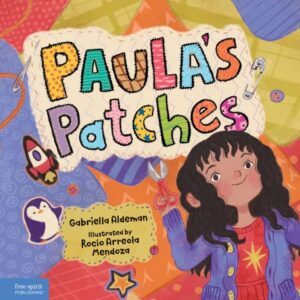 engaging, lyrically written, and include elements of fun and humor–and they cover a broad range of issues important to kids—from celebration of identity and family to tough topics like anxiety and grief. A good example of a Free Spirit book is Paula’s Patches by Gabriella Aldeman and illustrated by Rocío Arreola Mendoza, about a girl who is embarrassed when her hand-me-down pants rip at school. She comes up with a creative solution of making patches not only for herself, but to share with her friends as well. The book is an authentic and fun exploration of problem solving.
engaging, lyrically written, and include elements of fun and humor–and they cover a broad range of issues important to kids—from celebration of identity and family to tough topics like anxiety and grief. A good example of a Free Spirit book is Paula’s Patches by Gabriella Aldeman and illustrated by Rocío Arreola Mendoza, about a girl who is embarrassed when her hand-me-down pants rip at school. She comes up with a creative solution of making patches not only for herself, but to share with her friends as well. The book is an authentic and fun exploration of problem solving.
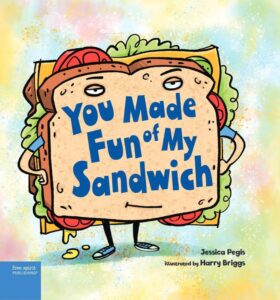 We include that element of fun and humor in our books even when tackling tough topics. This aspect is really front and center in our new release You Made Fun of My Sandwich by Jessica Pegis and illustrated by Harry Briggs. It is laugh out loud funny, and I love the speaker’s inquisitive voice. It starts with a child’s observation that a classmate is mocking their sandwich, and then we follow the child’s imaginative and hilarious thought process as they consider why. As fun as this book is for children to read, it tackles two tough topics: bullying and hunger.
We include that element of fun and humor in our books even when tackling tough topics. This aspect is really front and center in our new release You Made Fun of My Sandwich by Jessica Pegis and illustrated by Harry Briggs. It is laugh out loud funny, and I love the speaker’s inquisitive voice. It starts with a child’s observation that a classmate is mocking their sandwich, and then we follow the child’s imaginative and hilarious thought process as they consider why. As fun as this book is for children to read, it tackles two tough topics: bullying and hunger.
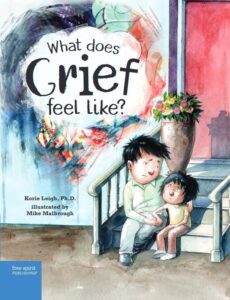 Another thing that really sets our list apart is that we seek out experts in children’s mental health for many of our books. Our picture book What Does Grief Feel Like? is written by Dr. Korie Leigh who has specialized in working with children and families experiencing grief and loss for over 16 years. When you read a Free Spirit book, you can trust that the representation, strategies, and tools are backed by experts. You can also trust that we’re addressing both these topics in an engaging kid-friendly way.
Another thing that really sets our list apart is that we seek out experts in children’s mental health for many of our books. Our picture book What Does Grief Feel Like? is written by Dr. Korie Leigh who has specialized in working with children and families experiencing grief and loss for over 16 years. When you read a Free Spirit book, you can trust that the representation, strategies, and tools are backed by experts. You can also trust that we’re addressing both these topics in an engaging kid-friendly way.
RVC: What’s the biggest misconception about SEL (social and emotional learning) picture books?
DP: Some people might think that SEL picture books are didactic and can only be used to teach emotions or other SEL skills or strategies. My favorite SEL picture books are the ones that tell authentic stories using rich language and engaging artwork. Any child or adult can fall in love with them, and they don’t have to read it for the SEL element. I also think that most good picture books are SEL picture books. We read books to learn about ourselves and the world, to feel a sense of belonging, to celebrate identity, to see how characters navigate challenges, or to build appreciation and joy. All of these are qualities of SEL picture books.
RVC: As an acquiring editor, who or what has most influenced you?
DP: My childhood influenced me a lot, and I continue to be inspired by the children around me. I also have to shout out the editors at Free Spirit. They are so talented and do amazing work. I’ll often peek into the manuscripts they’re working on, and I’m in awe of their thoughtful feedback to the authors they work with. It’s such a gift that I get to learn from them every day. It’s another reason I sometimes pinch myself—I’m surrounded by a lot of talent here at Free Spirit.
RVC: You’re a writer, too. What kind of creative nonfiction are you making?
DP: I’m working on memoir that I hope to start sending out to agents and editors within the next year. I also have several essays and poems on submission with literary journals. Almost everything I write is in exploration of my childhood in rural Ohio.
RVC: Any interest in writing picture books of your own?
DP: For sure. It’s not something I’m actively working on, but the temptation is there.
RVC: Since COVID, I’ve been asking everyone at least one health and wellness question. How do you defeat negativity—either internally or from outside yourself?
DP: Learning loving-kindness meditation was a gamechanger for me.
RVC: One final question for this part of the interview. What upcoming book are you especially excited about?
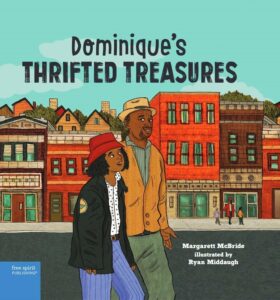 DP: The next Free Spirit book that I’m really looking forward to is Dominique’s Thrifted Treasures by Margarett McBride and illustrated by Ryan Middaugh. Please read it because it’s doing exactly what I said I love about SEL picture books. It’s a beautiful story that highlights community and shared experiences. Dominique receives a hand-me-down jacket from their Pawpaw and isn’t too enthused. However, after Mama comes home with a bag of thrifted clothes from the thrift store the next day, Dominique becomes fascinated by the unique story of each piece of clothing. They spend the day running errands with Pawpaw and running into people who previously owned each item Dominique is wearing. Thrifting is such a fun and relevant topic, and the idea of appreciating the community aspect of thrifting and the stories that the clothes tell is so touching. The artwork is beautiful, and I can’t wait to see this book in the world. It will be available in February 2024.
DP: The next Free Spirit book that I’m really looking forward to is Dominique’s Thrifted Treasures by Margarett McBride and illustrated by Ryan Middaugh. Please read it because it’s doing exactly what I said I love about SEL picture books. It’s a beautiful story that highlights community and shared experiences. Dominique receives a hand-me-down jacket from their Pawpaw and isn’t too enthused. However, after Mama comes home with a bag of thrifted clothes from the thrift store the next day, Dominique becomes fascinated by the unique story of each piece of clothing. They spend the day running errands with Pawpaw and running into people who previously owned each item Dominique is wearing. Thrifting is such a fun and relevant topic, and the idea of appreciating the community aspect of thrifting and the stories that the clothes tell is so touching. The artwork is beautiful, and I can’t wait to see this book in the world. It will be available in February 2024.
RVC: Alright, Deidra. It’s time for the LIGHTNING ROUND. I’ll zip out some questions and you zap back some answers. Are you ready?
DP: Sure!
RVC: Would you rather have a personal chef, a maid, or a masseuse?
DP: A personal chef, please!
RVC: What inanimate object would be the worst if it played loud dance music every time it was used?
DP: A pillow?
RVC: What’s the funniest word in the English language?
DP: Lollygag? I don’t know if I think any word is funny, but lollygagging brings me joy.
RVC: Your life is on the line. You need to sing one karaōke song to save it. What do you go with?
DP: “Bicycle Race” by Queen.
RVC: What’s the last SEL picture book you read that WOWed you?
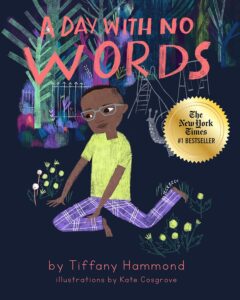 DP: So hard! I have a lot of favorites, but the most recent one I read that really moved me was A Day with No Words by Tiffany Hammond.
DP: So hard! I have a lot of favorites, but the most recent one I read that really moved me was A Day with No Words by Tiffany Hammond.
RVC: Let’s end with your favorite line from any Free Spirit picture book.
DP: I love the opening lines from I Think I Think A Lot by Jessica Whipple: “I think. I think a lot. I think I think a lot.” Such a cute, relatable, and important book.
RVC: Thanks so much, Deidra!


Awesome interview! Thanks to both of you!